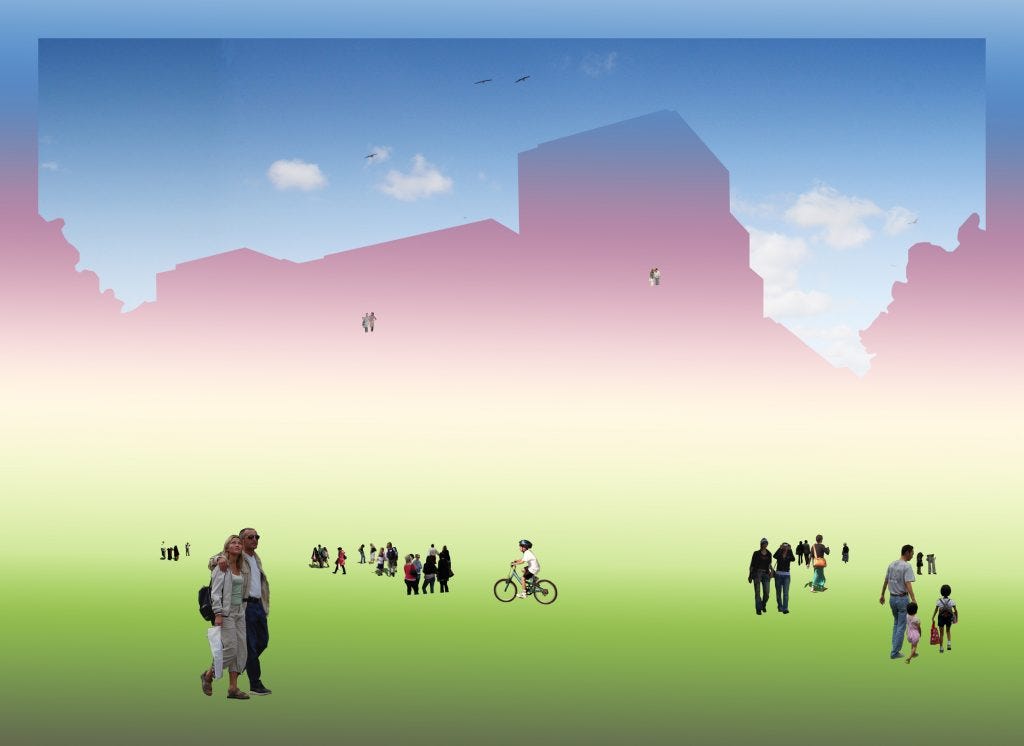
“I tend to be drawn to trying to making projects about changes in London that are hidden or invisible,” Max Colson tells me from the opposite end of a Zoom call. “Maybe it’s a sort of creative challenge that I set for myself, but I look for things that are not easily seen from street level, like security apparatus or privatised public spaces.”
Max’s documents of changing London has been mentioned in this newsletter before. Last December the writer and curator Matthew Harle wrote an issue for us about the director Patrick Keiller and the creeping sanitisation of Keiller’s London through digitally rendered architectural imagery. It was this kind of imagery that Colson used (or removed) to create his series Images of Enjoyment and Spectacle, highlighting how developers were literally airbrushing away some of the messier realities of the city.

A few years after that project Colson found himself drawn to another aspect of ‘invisible’ London: the so-called ‘iceberg homes’ that have subterranean extensions, making them larger beneath the ground than above.
“I made a film in 2017 called Construction Lines about a Knightsbridge billionaire’s iceberg home,” Colson says. “In the film I show the architectural plans of what was proposed along with a script that’s made up of a selection of the complaints that the neighbours submitted to the council. Some of the complaints are quite obnoxious and wonder what this billionaire might get up to underneath the ground. So the project was partly about people’s speculations about the one percent, a category of people that most of us don’t have any contact with. Mainly it was about this hidden city that’s hard to see and access but which is very much part of the architecture.”
There’s a direct line between Construction Lines and Colson’s more recent project, Offshore Capital, which has seen the artist create 3D laser scans of London properties owned by offshore companies, most of which are based in tax havens.
“I was blown away by when Private Eye put out an interactive map of all the properties owned by offshore companies” Colson explains. “I knew that London was a haven for offshore property but I was just astounded by the volume. I think we all know that there is this kind of hidden world in London, but what I found really interesting was that you can’t discern which properties are part of this network because, from ground level, they’re camouflaged by the architecture of the street.”
Around this time Colson had access to a LiDAR scanner, a piece of kit that uses a laser to create 3D digital representations of any environment you point it at. “I’d been looking for a way to use the scanner, because it has this very shadowy way of rendering the world,” he explains. “It renders architectural shapes through points and voids, so the aesthetic is shadowy and cavernous. I’m revealing information that people already know about, but the aesthetic of the LIDAR scanner is the thing that gives it that haunted, ghostly nature.”

To capture these images Colson ventures out on to the street wearing a backpack that contains some of the hardware, and holding the scanner itself which, when switched on, rotates in a manner that seems bound to attract attention. Particularly if you happen to be stood outside an oligarch’s mansion house.
“When I walk down the street people do get quite suspicious,” admits Colson, “because they’ve probably never seen this kind of device before, apart from maybe in the hands of someone from Google. I actually find it quite stressful!”
Max says that, along with the odd person making a Ghostbusters joke (“Which I love!”), he has had just one police stop to date, “when I was scanning in Mayfair a couple of weeks before the coronation and they were on high alert. The police spent about 25 minutes asking me questions, trying to work out if I was part of Just Stop Oil or if I was working for a foreign state. I showed them the Offshore Capital website and they were a bit bemused.”
Keep reading with a 7-day free trial
Subscribe to London in Bits to keep reading this post and get 7 days of free access to the full post archives.


